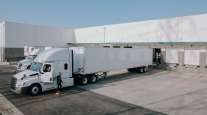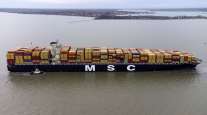Shipping Billionaires are in a High Seas ‘Arms Race’

A shopping spree by two billionaires is shaking up a shipping industry still recovering from years of falling rates and overcapacity.
Jacques Saade’s CMA CGM SA, the world’s third-largest container line, announced an order for nine massive vessels in September, after a year of tepid sales for new ships. Within days, Gianluigi Aponte’s Mediterranean Shipping Co., the No. 2 container line, confirmed it had lobbed in an order for 11 behemoths, each of which can hold 22,000 shipping containers, enough capacity for 44,000 cars or 8.8 million 50-inch TVs.
The orders amounted to almost $2.9 billion combined, according to London-based Vessels Value, an online ship-valuation database. Longer than 3 1/2 football fields, the container ships will be among the largest ever built.
Some analysts, however, say it’s the last thing the market needs right now.
“The problem with the industry as a whole is that there are just too many ships,” said Toby Yeabsley, an analyst at Vessels Value. “It’s a struggle to see where these are going to fit in.”
Ferry Captain
But brash bets are characteristic of ship owners, in a volatile and cyclical industry. Aponte, an Italian-born former ferry captain, started operating cargo ships in 1970 and amassed a fleet of 490 container vessels, ferries, cruise ships and stakes in port terminals. His son Diego became CEO in 2014. Saade formed CMA in Marseille after he moved from Lebanon in 1978. He built it into what has become France’s largest shipping company, helped by a 1992 bet on China’s economic growth. His son Rodolphe is now CEO.
Their success means Aponte has a net worth of $8.9 billion and Saade $4.4 billion, placing both men on the Bloomberg Billionaires Index, a daily ranking of the world’s 500 richest people. Both companies declined to comment on their founders’ net worth.
The purchases are emblematic of a trend toward bigger ships amid industry-wide consolidation, with global carriers becoming more dominant, according to Tom Bebbington, founder of consulting firm Container Logic.
The order demonstrates CMA CGM’s confidence in the coming years thanks to trends such as China’s recovering economy, the company said in an emailed statement. An MSC spokesman said the new vessels are expected to replace smaller ones and won’t substantially add to the carrier’s capacity.
The billionaires may be sensing that the market has hit bottom. Years of low rates have forced shipowners to destroy — or “scrap” — boats as young as eight years to ease a glut that has weighed them down. Asset prices have also plummeted, making ordering new boats more attractive, though at the risk of throwing supply and demand even further out of whack.
“It’s so finely balanced,” Yeabsley said. “That’s why it’s a shock to see these huge orders.”
The motive may not be entirely financial. With shipyards charging rock-bottom prices, the biggest operators have a low-cost opportunity to show who’s boss.
“It becomes kind of like an arms race,” said Lee Klaskow, a shipping analyst at Bloomberg Intelligence. “Who has the biggest ship?”
Such rivalries, however, become problematic when everyone piles in. In 2011, A.P. Moeller-Maersk A/S’s Maersk Line unit, the world’s largest container-shipping line, ordered more than 20 vessels with a capacity of more than 18,000 containers, and competitors raced to match it. That overcapacity contributed to the crash in rates that continues to hobble the industry today, according to critics.
This time around, Maersk is sitting it out.
“We have no immediate plans of ordering ships,” Chief Financial Officer Jakob Stausholm said in a conference call with analysts earlier this month. “We are getting the ships that we need for now.”
With assistance by Ivan Levingston




